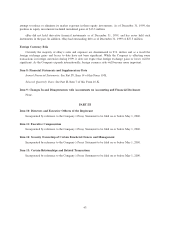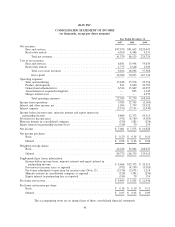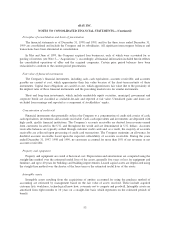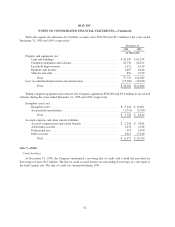eBay 1999 Annual Report Download - page 58
Download and view the complete annual report
Please find page 58 of the 1999 eBay annual report below. You can navigate through the pages in the report by either clicking on the pages listed below, or by using the keyword search tool below to find specific information within the annual report.Principles of consolidation and basis of presentation
The financial statements as of December 31, 1998 and 1999, and for the three years ended December 31,
1999 are consolidated and include the Company and its subsidiaries. All significant intercompany balances and
transactions have been eliminated in consolidation.
In May and June of 1999, the Company acquired four businesses, each of which were accounted for as
pooling of interests (see Note 3—‘‘Acquisitions’’). Accordingly, all financial information included herein reflects
the consolidated operations of eBay and the acquired companies. Certain prior period balances have been
reclassified to conform to the current period presentation.
Fair value of financial instruments
The Company’s financial instruments, including cash, cash equivalents, accounts receivable, and accounts
payable are carried at cost, which approximates their fair value because of the short-term maturity of these
instruments. Capital lease obligations are carried at cost, which approximates fair value due to the proximity of
the implicit rates of these financial instruments and the prevailing market rates for similar instruments.
Short and long-term investments, which include marketable equity securities, municipal, government and
corporate bonds are classified as available-for-sale and reported at fair value. Unrealized gains and losses are
excluded from earnings and reported as a component of stockholders’ equity.
Concentration of credit risk
Financial instruments that potentially subject the Company to a concentration of credit risk consist of cash,
cash equivalents, investments and accounts receivable. Cash, cash equivalents and investments are deposited with
high credit, quality financial institutions. The Company’s accounts receivable are derived from revenue earned
from customers located in the U.S. and throughout the world and are denominated in U.S. dollars. Accounts
receivable balances are typically settled through customer credit cards and, as a result, the majority of accounts
receivable are collected upon processing of credit card transactions. The Company maintains an allowance for
doubtful accounts receivable based upon the expected collectibility of accounts receivable. During the years
ended December 31, 1997, 1998 and 1999, no customers accounted for more than 10% of net revenues or net
accounts receivable.
Property and equipment
Property and equipment are stated at historical cost. Depreciation and amortization are computed using the
straight-line method over the estimated useful lives of the assets, generally five years or less for equipment and
furniture, and up to 40 years for buildings and building improvements. Leased capital assets are depreciated using
the straight-line method over the shorter of the lease term or the estimated useful lives of the assets.
Intangible assets
Intangible assets resulting from the acquisitions of entities accounted for using the purchase method of
accounting are estimated by management based on the fair value of assets received. These include acquired
customer lists, workforce, technological know how, covenants not to compete and goodwill. Intangible assets are
amortized from eight months to 10 years on a straight-line basis which represents on the estimated periods of
benefit.
eBAY INC.
NOTES TO CONSOLIDATED FINANCIAL STATEMENTS—(Continued)
53
























